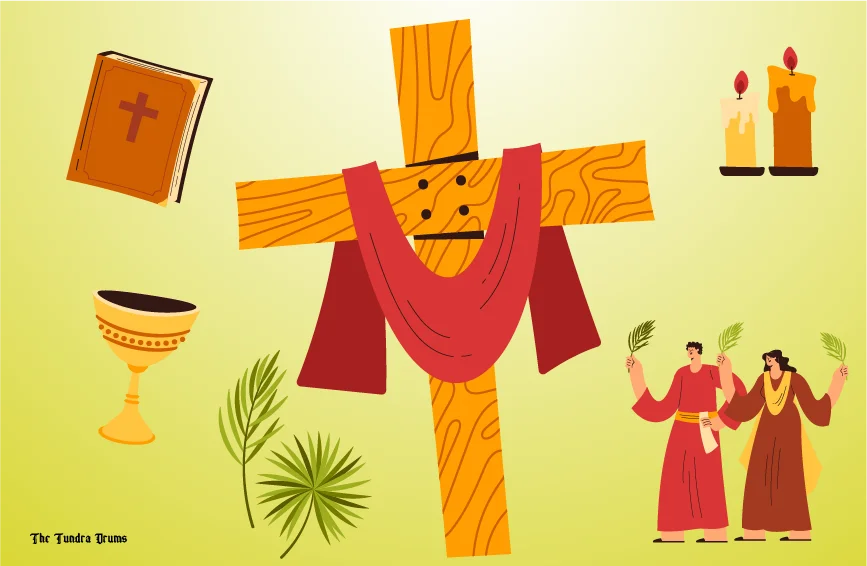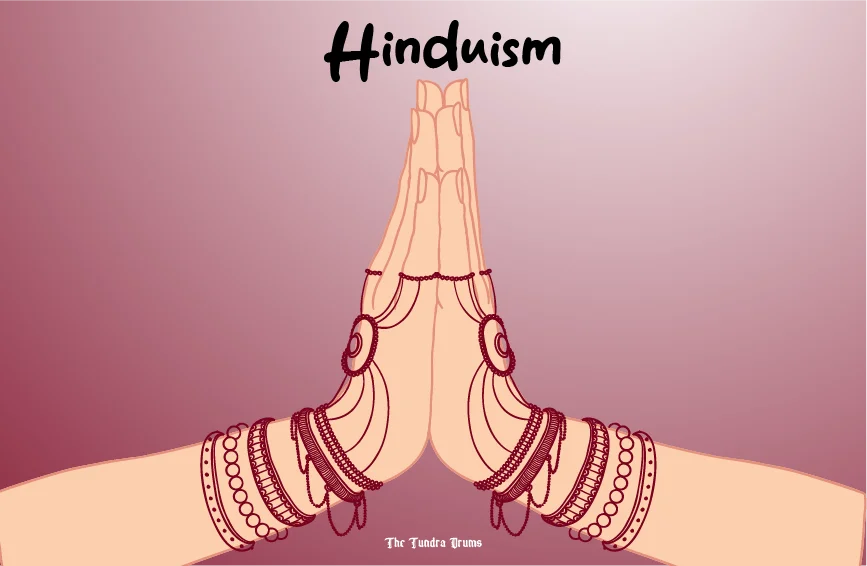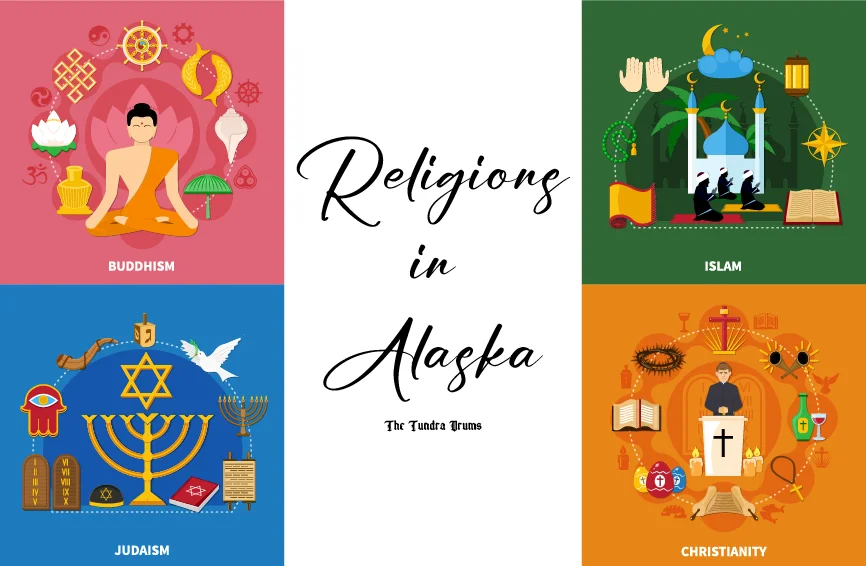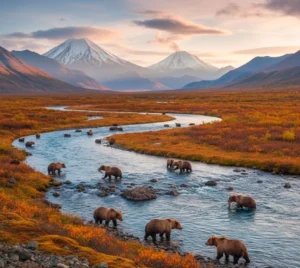| Religions in Alaska encompass a wide range of beliefs and practices, reflecting the state’s diverse cultural heritage and history. |
When you think of Alaska, you might picture its stunning mountains, vast glaciers, and breathtaking Northern Lights. But Alaska’s spiritual world is just as captivating. With over 20 indigenous languages spoken by Native Alaskan tribes, along with English and Russian, the state boasts a rich mix of cultural and religious traditions. This blend is evident in how people in Alaska practice their faith, from ancient native customs to modern Christian rituals. The religions in Alaska offer a fascinating look into the state’s unique blend of faith, culture, and community. Let’s dive into the top five religions shaping Alaska’s spiritual and cultural landscape.
Different Religion Groups in Alaska
Here’s a list of Alaska’s religious affiliations:
| Religion/Affiliation | Percentage |
| Christianity | 62% |
| – Protestantism | 37% |
| – Roman Catholicism | 16% |
| – Mormonism | 5% |
| – Eastern Orthodoxy | 5% |
| – Jehovah’s Witnesses | <1% |
| – Other Christian | <1% |
| Other Religions | 6% |
| – Buddhism | 1% |
| – Hinduism | <1% |
| – Judaism | <1% |
| – Islam | <1% |
| – Smaller faiths | 4% |
| No Religion | 31% |
| – Jehovah’s Witnesses | 1% |
Different Religions in Alaska
The following are the main religions practiced in Alaska:
- Christianity
- Other Christian denominations
- Buddhism
- Islam
- Hinduism
- Judaism
- Smaller religious groups
1. Christianity: The Major Player

Christianity is the predominant religion practiced among Alaska’s 736,812 residents. According to statistics, around 62% of Alaskans identify as Christians. This broad category includes several key groups, each contributing traditions and practices to Alaska’s cultural mosaic.
a. Roman Catholicism: A Key Influence

Based on Jesus’ teachings, Christianity includes several main branches, with Roman Catholicism being the largest. While every Roman Catholic is a Christian, not everyone is Roman Catholic. Out of the approximately 2.3 billion Christians worldwide, around 1.3 billion are Roman Catholics.
Roman Catholicism is a significant Christian presence in Alaska and influences various aspects of community life. For instance, Catholic institutions like St. Mary’s Catholic School play a vital role in education and community support. However, despite these contributions, the Catholic community in Alaska might sometimes feel less prominent and face challenges in visibility and influence compared to the larger Protestant groups.
b. Protestantism: A Diverse Spectrum
This is the largest Christian group in Alaska. Within Protestantism, you’ll encounter a range of beliefs and practices:
- Evangelical Protestants: Known for their lively worship services and active community outreach. Churches like the Anchorage Baptist Temple are prime examples, with their vibrant services and extensive community programs. However, the energetic style of Evangelical worship may not appeal to everyone, leading to a diverse Protestant experience.
- Mainline Protestants: This group comprises denominations like the United Methodist Church and the Evangelical Lutheran Church in America. These groups are known for their more traditional worship and strong commitment to social justice. For instance, the First Presbyterian Church in Anchorage provides various community support programs, including food banks and shelters.
- Historically Black Protestants: Adds a distinctive dimension to Alaska’s Protestant community, with churches like Bethel African Methodist Episcopal Church offering a sense of cultural heritage and community support.
c. Mormonism (5%) and Eastern Orthodoxy (5%):
Mormonism and Eastern Orthodoxy enhance Alaska’s religious diversity. The Church of Jesus Christ of Latter-day Saints, known for its focus on community and family values, maintains several centers across the state. Meanwhile, Eastern Orthodoxy enriches Alaska’s spiritual landscape with its profound liturgical traditions. Despite their contributions, these groups are smaller than the predominant Protestant and Catholic communities.
2. Other Christian Denominations: Enhancing Diversity

In addition to the major Christian groups, Alaska hosts several smaller Christian denominations, each contributing uniquely to the state’s religious fabric.
- Jehovah’s Witnesses and Other Christians bring their distinct practices and perspectives to Alaska. Jehovah’s Witnesses, for instance, are known for their door-to-door evangelism, which contrasts with other denominations’ community outreach methods. Despite their smaller size, their commitment to their faith is evident in their active community presence.
- Mormonism and Eastern Orthodoxy also enrich Alaska’s Christian landscape. The Mormon community is known for its strong family values and community service, while Eastern Orthodoxy in Alaska contributes a rich tradition of liturgical practices and theological depth. However, both groups represent a smaller segment of Alaska’s Christian population than the dominant Protestant and Catholic communities.
3. Buddhism

While Christianity remains the dominant religion in Alaska, non-Christian faiths are increasingly making their presence felt. These religions also contribute significantly to the state’s rich cultural and spiritual diversity. This growing religious pluralism reflects a broader trend of expanding spiritual practices and beliefs beyond the traditional Christian framework.
Buddhism focuses on the principles of meditation and mindfulness. In Alaska, Buddhist centers such as the Alaska Buddhist Temple offer dedicated spaces for individuals seeking to practice meditation, explore Buddhist teachings, and engage in mindfulness practices. These centers provide a tranquil environment that contrasts with the often fast-paced lifestyle of modern living. However, Buddhism represents a relatively small segment compared to the larger Christian populations.
- Alaska Buddhist Temple: This temple is a critical hub for the local Buddhist community, hosting meditation sessions, educational programs, and cultural events. It is essential in fostering community and spiritual growth among its members.
- Growth of Buddhism: Although Buddhism remains a minor presence compared to the predominantly Christian population, it is steadily expanding. This increase is primarily due to a rising interest in meditation and mindfulness among individuals exploring alternative spiritual practices.
4. Islam

Each religion has a more minor but significant presence in Alaska. For example, the Anchorage Islamic Center supports the Muslim community with resources and services. Meanwhile, mosques and Islamic centers in Alaska offer religious services, community support, and educational programs. These institutions are vital for fostering understanding and engagement between Muslim and non-Muslim residents. Nevertheless, their size and impact are relatively limited compared to the larger Christian groups.
5. Hinduism

Among the various religions in Alaska, Hinduism is a notable non-Christian faith that has made its mark. It introduces practices such as yoga and meditation to the state. Hindu temples and cultural organizations offer opportunities for worship, festivals, and community gatherings that highlight Hindu traditions and values. Although the presence of Hinduism in Alaska is growing, it remains a minor part of the state’s religious landscape. Its numbers are relatively modest, and its influence may not be as pronounced as that of the larger religious groups.
6. Judaism

Jewish communities contribute to the diversity of religious practices in Alaska through synagogues and cultural events. Jewish organizations in the state offer religious services, educational opportunities, and social events that enrich the local cultural landscape.
7. Smaller Religious Groups in Alaska

Various smaller religious groups, including Sikhism and indigenous spiritual practices, further diversify the spiritual environment of Alaska. These groups often contribute to local cultural events and provide unique perspectives on spirituality. Although they are smaller in number, their impact is noticeable in specific communities.
Critical Insights
Although Christianity, particularly Protestantism, is prominent in Alaska, the growing visibility of non-Christian religions underscores the state’s evolving cultural landscape. While Christian groups often lead community events and services, the rising presence of non-Christian faiths such as Buddhism and Islam reflects broader national trends and enriches Alaska’s multicultural identity. Understanding these Alaska religious demographics is crucial for appreciating how various religions interact and influence daily life. This awareness also highlights the importance of addressing the opportunities and challenges associated with religious diversity, providing a deeper and more nuanced view of the state’s complex spiritual landscape.












